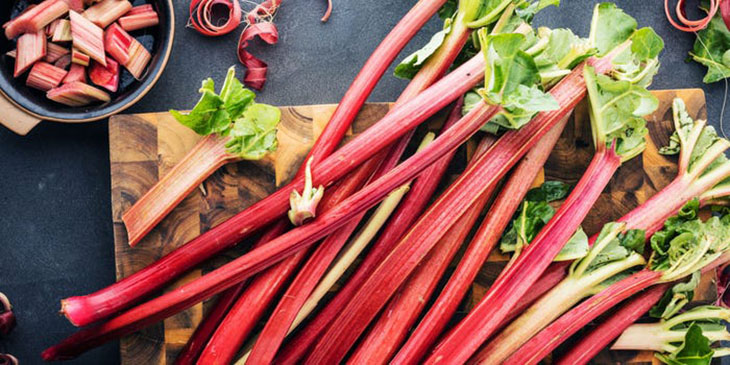2. Rhubarb

Rhubarb is a vegetable that many people use in cooking and recipes as if it were a fruit. Though it is native to Asia, it can be found all over the world, including the United States. The plant prefers cooler environments because it does not thrive in heat. The long red leafstalks emerge in the spring and reach their peak in mid-April. Only the plant’s stalks are edible. Toxins and high levels of oxalic acid are found in the leaves. The stalks are fleshy, sour, and acidic on their own. While they can be eaten raw, most people prefer them cooked. Rhubarb has a long history that dates back to ancient Chinese medicine. It was also used in the civilizations of the ancient Arabs, Greeks, and Romans. Rhubarb is well-known for its tart flavor and thick stalks, which are typically cooked with sugar. The stalks range in color from red to pink to pale green and have a celery-like consistency. Cold winters are required for the growth of this vegetable. As a result, it is primarily found in mountainous and temperate regions worldwide, particularly in Northeast Asia. It’s also a popular garden plant in the United States and Northern Europe. There are numerous varieties and species. The most common variety in the West is known as culinary or garden rhubarb (Rheum x hybridum).
It is now widely used in jams, pies, compotes, and even drinks. Rhubarb is a spring vegetable that is still considered to be truly seasonal. The vibrant pink stalk of this perennial plant is edible, and it is almost always cooked with a lot of sugar because it is very sour. It contains a lot of oxalates, which are a major cause of kidney stones. Raw rhubarb is quite sour, almost as much as lemon. Eating raw rhubarb stalks is completely safe, and we recommend trying a small slice the next time you cook with it to get the most out of its natural flavor. What rhubarb tastes like is really a question of what it tastes like after it has been cooked with sugar to make it more palatable. Then it tastes pleasantly tart, like a green apple, with a very slight vegetal celery flavor. Many people associate rhubarb flavor with strawberries because the two are frequently paired together (they come into season at the same time, and strawberry’s sweet flavor helps counteract rhubarb’s sour flavor).
Rhubarb is a good source of vitamin K, which is necessary for bone health and blood clotting. Rhubarb’s vitamin A content may also aid in the fight against free radicals, which cause skin damage and premature aging, keeping your skin looking healthy and youthful. It also contains a lot of antioxidants and a lot of other vitamins and minerals that are good for your health. Rhubarb contains a lot of calcium oxalate. While the substance is primarily found in the leaves, it is also present in the stalks. Too much calcium oxalate in your diet can cause hyperoxaluria, which is the accumulation of oxalate crystals in various organs. These crystals may also promote kidney stone formation and increase your risk of kidney failure. The vitamin K content of rhubarb may also interact with the blood-thinning medication warfarin. It may reduce the effectiveness of the medication, so consult your doctor before incorporating rhubarb into your diet.



